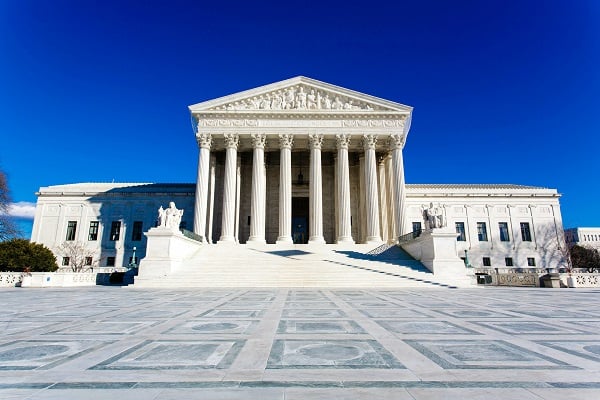
U.S. Supreme Court Stays EPA Ozone Interstate Transport Rule

On Thursday, in Ohio v. Environmental Protection Agency, the U.S. Supreme Court stayed an Environmental Protection Agency (EPA) rule that would have required the implementation of additional, significant emissions controls in power plants, pipelines, cement factories, glass factories, iron and steel mills, paper mills, and other industrial facilities across 23 states. The stay provides relief to those industries as they challenge various aspects of the rule in the U.S. Court of Appeals for the D.C. Circuit — challenges on which the Supreme Court found the states and industries were likely to succeed.
To control pollution, the Clean Air Act directs EPA to set National Ambient Air Quality Standards (NAAQS) for levels of certain air pollutants such as ozone but empowers states to implement those standards in the first instance. Such state implementation plans (SIPs) must take into account emissions that travel outside a state to neighboring “downwind” states. Under the act’s “good neighbor” provision, a SIP must include provisions to eliminate the state’s “significant contribution” to downwind states’ inability to attain or maintain compliance with EPA’s air-quality standards. If a given state’s SIP fails to do so, EPA can disapprove the SIP and substitute a federal implementation plan (FIP) in its place.
After EPA set a new NAAQS for ozone in 2015, numerous states proposed SIPs. In 2022, EPA disapproved the good neighbor provisions in 24 states’ SIPs. Many of those states challenged the SIP disapprovals in the circuit courts, and 12 won stays of the SIP disapprovals. As a result, fewer than half of the SIP disapprovals are currently enforceable.
As court after court issued stay after stay, EPA promulgated its FIP, which required power plants and other industrial facilities to install a range of costly control technologies. The states and the affected industries challenged the FIP in the D.C. Circuit, raising a multitude of arguments against EPA’s statutory interpretation, technical analysis, and adherence to the Administrative Procedure Act. Those challenges on the merits are ongoing, but in the meantime, the petitioners sought a stay of the rule pending completion of the litigation. By a 2–1 vote, the D.C. Circuit denied the stay. The petitioners then sought relief from the Supreme Court, which — in an unusual move — heard oral argument on the stay applications in February.
On Thursday, the Court issued its decision. By a 5–4 vote, the Court granted the petitioners’ request for a stay of the rule. Applying the usual stay factors, Justice Neil Gorsuch, writing for the majority, found that both sides had presented compelling arguments about irreparable harms and the public interest but that petitioners were entitled to a stay because they were likely to succeed on the merits.
In particular, the Supreme Court held that petitioners were likely to succeed on their argument that the FIP is arbitrary and capricious because EPA had not adequately explained the basis for its conclusion that the FIP should remain in place even if one or more of the states originally included in the rule dropped out. To determine which controls to impose, EPA had charted the cost effectiveness of possible emission controls across all the regulated states and identified a point of diminishing marginal cost effectiveness, also called the “knee in the curve.” In other words, “EPA had determined which emissions-control measures were cost effective at addressing downwind ozone levels based on an assumption that the FIP would apply to all covered States.”[1] As commenters pointed out, however, “a different set of States might mean that the ‘knee in the curve’ would shift.”[2] “After all,” the Court reasoned, “each state differs in its mix of industries, in its pre-existing emissions-control measures, and in the impact those measures may have on emissions and downwind air quality.”[3]
The Supreme Court held that EPA had failed to give commenters the “reasoned response” required by the Administrative Procedure Act. At oral argument, “the government acknowledged that it could not represent with certainty whether the cost-effectiveness analysis it performed collectively for 23 States would yield the same results and command the same emissions-control measures if conducted for, say, just one State.”[4] As a result, the Court said, the petitioners are likely to prevail on the merits and a stay should issue, preventing EPA from enforcing the FIP while the merits of the petitioners’ challenges are being litigated.
Among other takeaways, Ohio v. EPA proves the value of challenging an agency’s factual assumptions during the notice-and-comment period. An agency’s failure to give an adequate response to such comments can nullify the whole rule. The case also establishes an important principle for future cases: that nonrecoverable compliance costs are an irreparable harm that can justify a stay.
[1] Ohio v. Environmental Protection Agency, 603 U.S. __, ___ (2024) (slip op., at 6).
[2] Id. at ___ (slip op., at 7) (referencing comments of Air Stewardship Coalition and Portland Cement Association).
[3] Id.
[4] Id. at ___ (slip op., at 12–13)
This post is as of the posting date stated above. Sidley Austin LLP assumes no duty to update this post or post about any subsequent developments having a bearing on this post.

